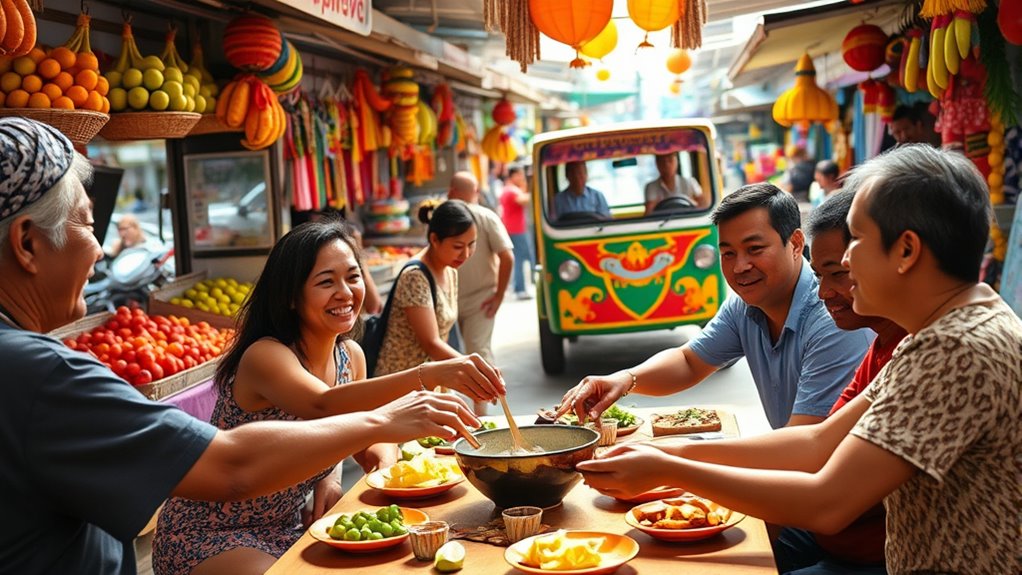When visiting the Philippines, respect and hospitality are key. Always greet people warmly, using polite titles like *Ma’am* and *Sir*. Dress modestly, especially in public and religious settings. Meals are shared family-style, so wait for elders to start eating first. When entering homes, remove your shoes and accept any refreshments offered. Small, nicely wrapped gifts are appreciated, but avoid certain flowers. Embrace these customs, and you’ll surely enjoy your stay while discovering even more cultural nuances.
Key Takeaways
- Always greet with a smile and use polite titles like *Ma’am* or *Sir*, incorporating “po” and “opo” for respect, especially towards elders.
- Remove shoes when entering homes and accept refreshments offered to show appreciation and respect for the host’s hospitality.
- Dress modestly, adhering to local customs; formal occasions require the Barong Tagalog for men, while casual settings demand covering shoulders and legs.
- Engage in communal dining by allowing elders to eat first, sharing meals, and expressing gratitude to the host after the meal.
- Thoughtfully bring small gifts when visiting homes, ensuring they are nicely wrapped and avoiding chrysanthemums or white lilies.
Understanding Filipino Culture
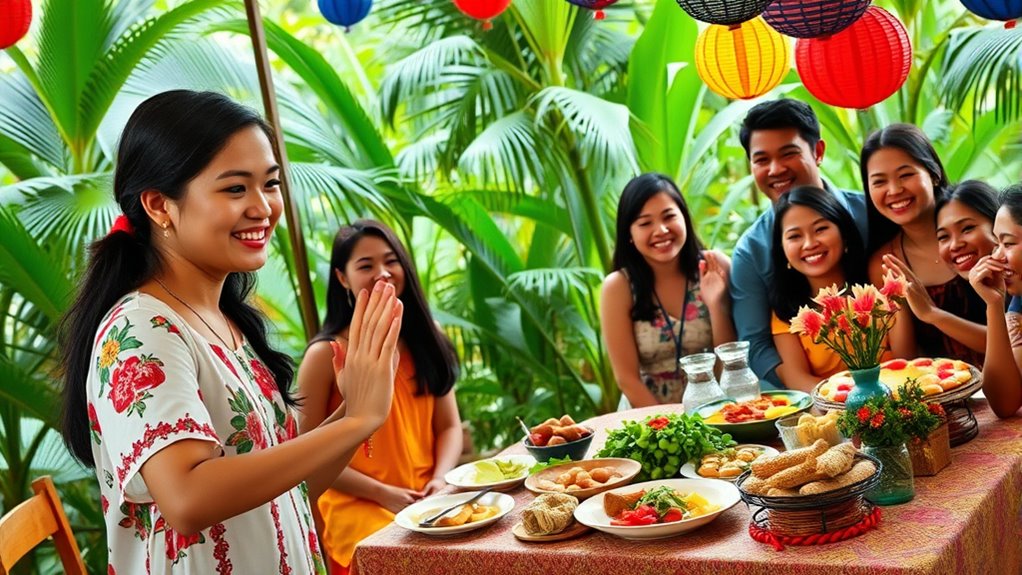
When you step into the Philippines, you’ll quickly notice that understanding Filipino culture is key to making a good impression. Social harmony takes precedence over personal desires, so you’ll want to be mindful of your interactions.
The concept of *hiya* influences behavior, reminding you to respect elders and authority figures. Hospitality and friendliness are ingrained traits, making you feel welcomed.
Family holds immense importance; kinship ties shape social dynamics, and extended family gatherings are common during celebrations.
As Christianity greatly influences daily life, you’ll see religious symbols everywhere. Festivals like MassKara and Kadayawan showcase the rich cultural heritage, featuring large gatherings and shared meals.
Embrace the warmth, humor, and respect embedded in Filipino culture to connect meaningfully.
Dress Code Essentials

Understanding the dress code in the Philippines is essential for making a positive impression, especially if you’re attending formal events or local gatherings.
For formal occasions like weddings, men often wear the Barong Tagalog, showcasing Filipino heritage. When attending business meetings, opt for a dark-colored suit to convey professionalism and respect.
In casual settings, choose modest outfits like polos or dresses with traditional flair, avoiding beachwear in urban areas. Always remember to dress modestly in public, covering your shoulders and legs.
In religious settings, guarantee your attire reflects respect for local customs and traditions. Balancing traditional and modern styles can help you blend in while still expressing your individuality.
Dining Etiquette
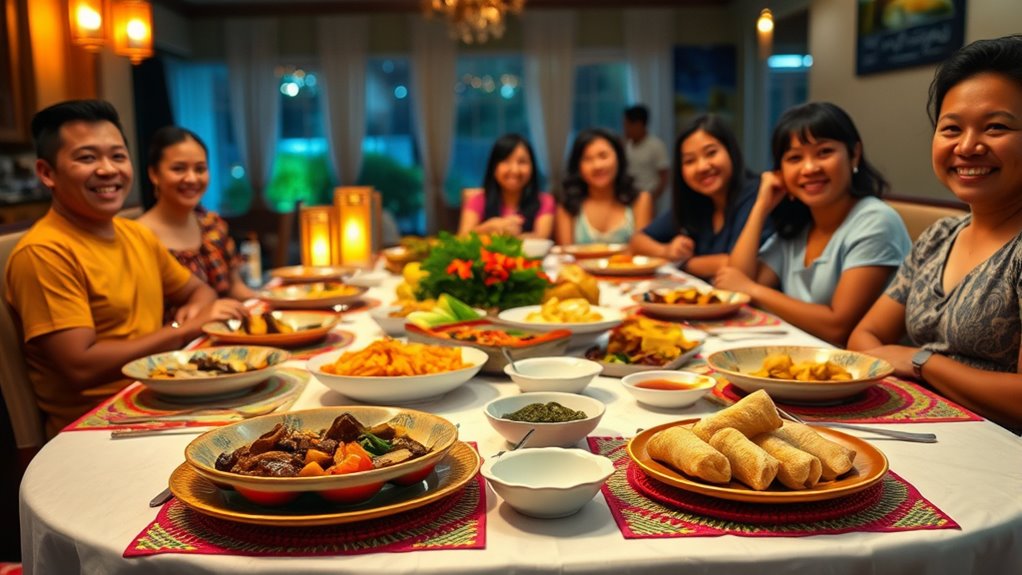
Experiencing Filipino dining etiquette can be just as important as knowing how to dress appropriately. Meals are often served family-style, promoting communal eating, so be prepared to share.
Respect for elders is essential; always let them eat first and wait for the oldest person to start before you dig in. Rice is a staple, so make certain your plate is well-stocked before taking seconds.
Using your right hand to eat is customary, while the left should stay at your side. Saying “kain tayo” before starting shows appreciation.
If you’re invited to a kamayan feast, embrace the tradition of eating with your hands.
Finally, don’t rush off after the meal; engage in conversation and express gratitude to your host for a warm dining experience.
Interaction and Communication

How do you navigate the nuances of interaction and communication in the Philippines?
Start with respectful communication; use polite titles like *Ma’am* or *Sir*, especially for elders.
Filipinos often express opinions indirectly to maintain harmony and avoid losing face, so pay attention to tone and body language.
When refusing, expect hesitations instead of direct no’s.
Remember to greet warmly, and don’t be surprised by handshakes or cheek-to-cheek kisses among friends.
Keep in mind that humor helps ease tensions.
Practicing *pakikisama*—valuing relationships—will serve you well.
Finally, always show respect for hierarchy; this reflects in how you communicate.
Visiting Homes
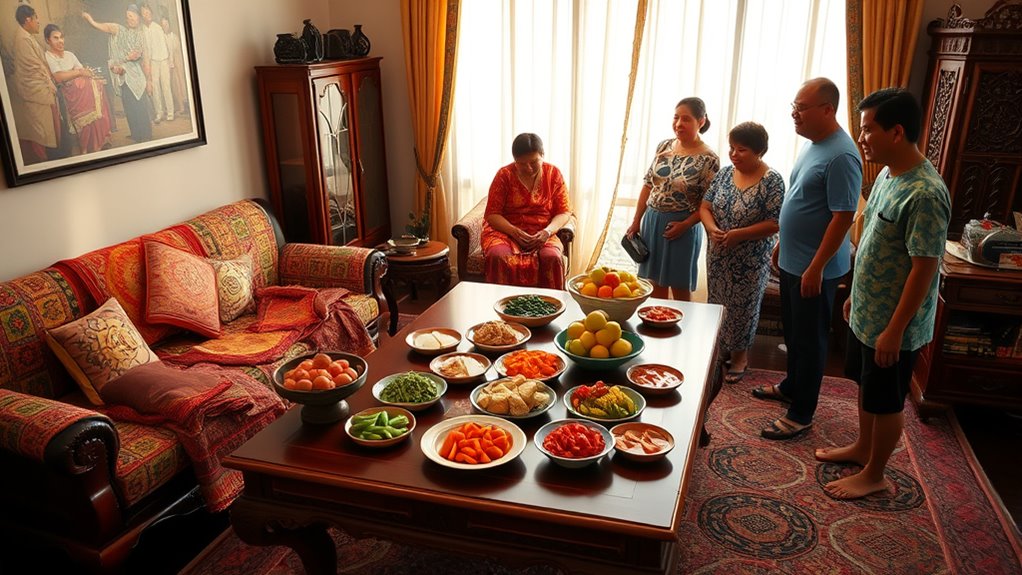
What should you expect when visiting a Filipino home? First, you’ll likely need to remove your shoes to show respect for cleanliness. Your host might offer you slippers to wear inside.
It’s polite to accept any refreshments offered, as declining can come off as rude. You’ll notice the finest crockery and cutlery being used, showcasing their hospitality.
Bringing a small gift like sweets or flowers is a thoughtful gesture, but avoid chrysanthemums or white lilies. Remember to express gratitude after meals, as sharing dishes is common.
Finally, be modestly dressed, especially in traditional settings, and compliment your host on their home or food to build rapport. Enjoy the warmth and generosity that Filipino homes embody!
Respecting Elders

Filipino culture places a strong emphasis on respecting elders, a value that carries over into all aspects of daily life, including home visits.
When greeting elders, always acknowledge the eldest person first and use formal language. The “mano” gesture—placing the elder’s hand on your forehead—demonstrates deep respect, as does bowing your head slightly.
Address grandparents as “Lolo” or “Lola,” and use honorifics like “Tito” or “Tita” for other relatives. In public, maintain respectful posture and eye contact; gentle handshakes or hugs are suitable for close relationships.
The Importance of Family
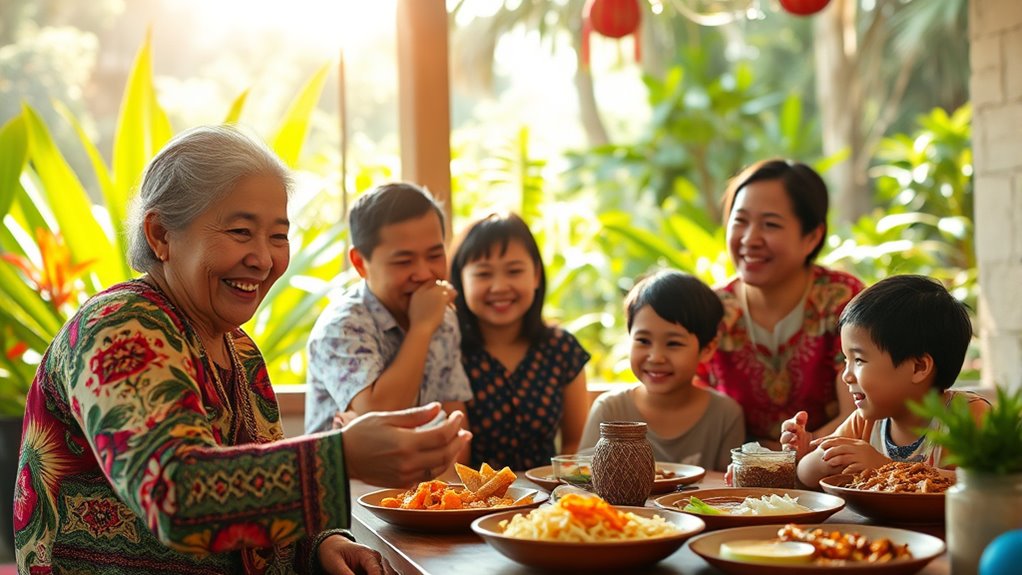
While visiting the Philippines, you’ll quickly realize that family isn’t just important—it’s the very fabric of society. The concept of “kapamilya” signifies that family ties extend well beyond the nuclear unit, creating a vast network of support.
Here, gatherings foster unity and cultural traditions, ensuring values are passed down through generations. You’ll notice that respect for elders is paramount, with younger members expected to care for their parents.
Family provides not only emotional backing but also financial support during tough times. In this culture, shared experiences and communal possessions reinforce bonds, highlighting loyalty and obligation.
Understanding this deep-rooted connection to family will enrich your experience and interactions with Filipinos.
Common Social Values
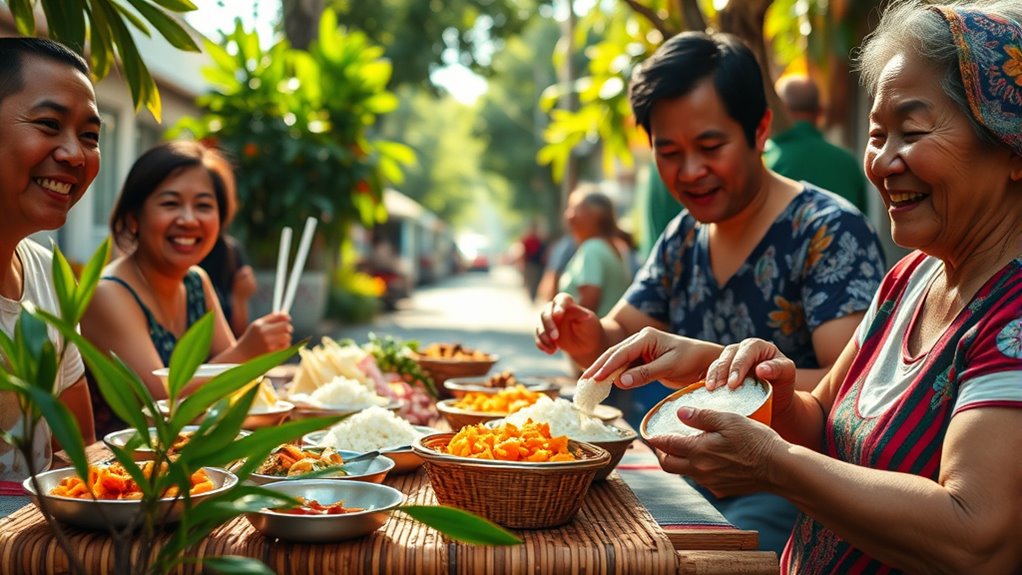
Harmony is a cornerstone of Filipino social values, shaping interactions and relationships within communities.
You’ll notice that respect and dignity, or “dangal,” are paramount, especially towards elders, who are addressed with polite terms like “po” and “opo.”
Filipinos excel in hospitality, making sure guests feel welcomed and comfortable.
Filipinos take pride in their hospitality, ensuring every guest feels warmly welcomed and at home.
Dress modestly, particularly in public or religious settings, as this reflects a deep-rooted cultural norm.
The value of “pakikisama” encourages you to get along with others and maintain social harmony.
Additionally, the concept of “utang na loob” emphasizes gratitude and the importance of repaying favors.
Navigating Personal Space
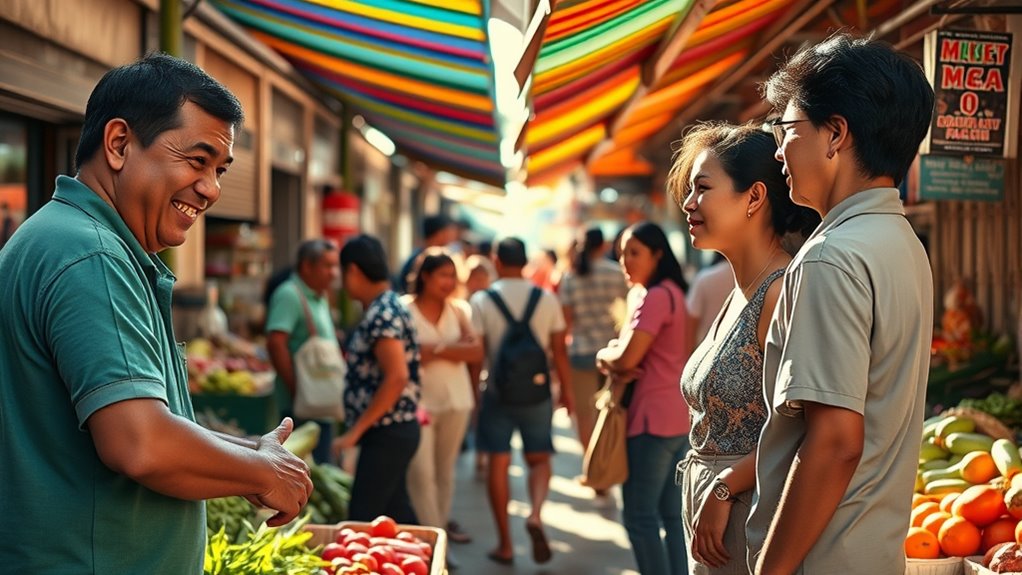
When visiting the Philippines, you might find that personal space differs considerably from what you’re used to.
In Filipino culture, physical closeness is common among family and friends, with privacy often taking a backseat. Family members live in close quarters, and shared spaces are the norm. You’ll notice that greetings often involve hugs or handshakes, especially among close friends, and gestures like the “mano” are customary to show respect to elders.
Community ties are strong here, so be prepared for large gatherings and an inviting atmosphere. As a visitor, being open-minded about the lack of personal space can enhance your experience, allowing you to connect more deeply with the locals and their cultural values.
Embracing Filipino Hospitality

Filipino hospitality is a hallmark of the culture, welcoming you with warmth and generosity that can be both surprising and delightful. Known as *magiliw na pagtanggap*, this tradition stems from pre-colonial times when communities embraced outsiders.
Filipino hospitality, or *magiliw na pagtanggap*, warmly welcomes you, reflecting a rich tradition of generosity and community.
You’ll often hear welcoming phrases like *Tulóy ka/kayó* (You may come in) and *Kumain ka muna* (Eat first) upon entering a home. Expect to share meals, as food is central to hospitality here.
Remember to use polite language, especially *po* and *opo*, to show respect. Embrace the friendliness and humor of your hosts, and don’t hesitate to appreciate their generosity.
Whether in a home or a resort, the essence of Filipino hospitality will leave a lasting impression.
Frequently Asked Questions
What Are Common Gifts to Bring When Visiting a Filipino Home?
When you’re visiting a Filipino home, common gifts include food items like baked goods, fruit baskets, or coffee and tea sets, which are always appreciated.
Personalized gifts, like mugs, show thoughtfulness, while flowers can be a nice touch—just avoid chrysanthemums and white lilies.
Remember to wrap your gifts elegantly, as presentation matters.
Ultimately, your gesture of respect and appreciation is what counts most in Filipino culture.
How Should I Address People in Formal Settings?
When you’re in formal settings, always address people with respect. Use honorifics like “po” and “opo,” especially for elders.
For professionals, stick to their titles followed by their surnames, like “Dr. Santos.”
Start greetings formally, saying “Good morning, sir/ma’am.”
In written communication, maintain this formality with clear salutations and respectful closings.
Keep your tone professional and avoid casual language to guarantee you convey respect and seriousness in your interactions.
Is It Acceptable to Take Photos in Public Spaces?
Did you know that around 80% of Filipinos are comfortable being photographed in public spaces?
Yes, it’s generally acceptable to take photos in places like streets and parks due to lower privacy expectations.
Just keep in mind that while you can capture everyday life, it’s wise to engage politely with locals and respect their space.
If you’re in private areas, always seek permission first to avoid misunderstandings.
Happy snapping!
Are There Any Cultural Taboos I Should Be Aware Of?
When exploring Filipino culture, you should be aware of several taboos. Avoid boasting about your achievements; modesty is valued.
Be cautious with the number 13, as it’s considered unlucky. When dining, don’t use your left hand to eat or pass food.
Also, be mindful of local beliefs, like avoiding taking food from wakes. Understanding these cultural sensitivities will help you connect better with the locals and show respect for their traditions.
How Do I Handle Disagreements Politely in Conversations?
To handle disagreements politely, focus on maintaining a calm demeanor. Instead of directly confronting someone, use indirect communication and pay attention to non-verbal cues.
Listen actively, especially to those in authority, and aim for group consensus. Avoid discussing sensitive topics in social settings, and always address conflicts quietly and respectfully.
Conclusion
By embracing Filipino etiquette, you’ll not only show respect but also plunge into a vibrant culture. Sure, it might feel overwhelming at first, but think of it as a dance—once you learn the steps, you’ll flow with grace. Imagine sharing hearty laughter over a meal, exchanging warm smiles, and feeling the genuine hospitality that envelops you. So, plunge in, connect with locals, and create unforgettable memories while honoring their rich traditions.
